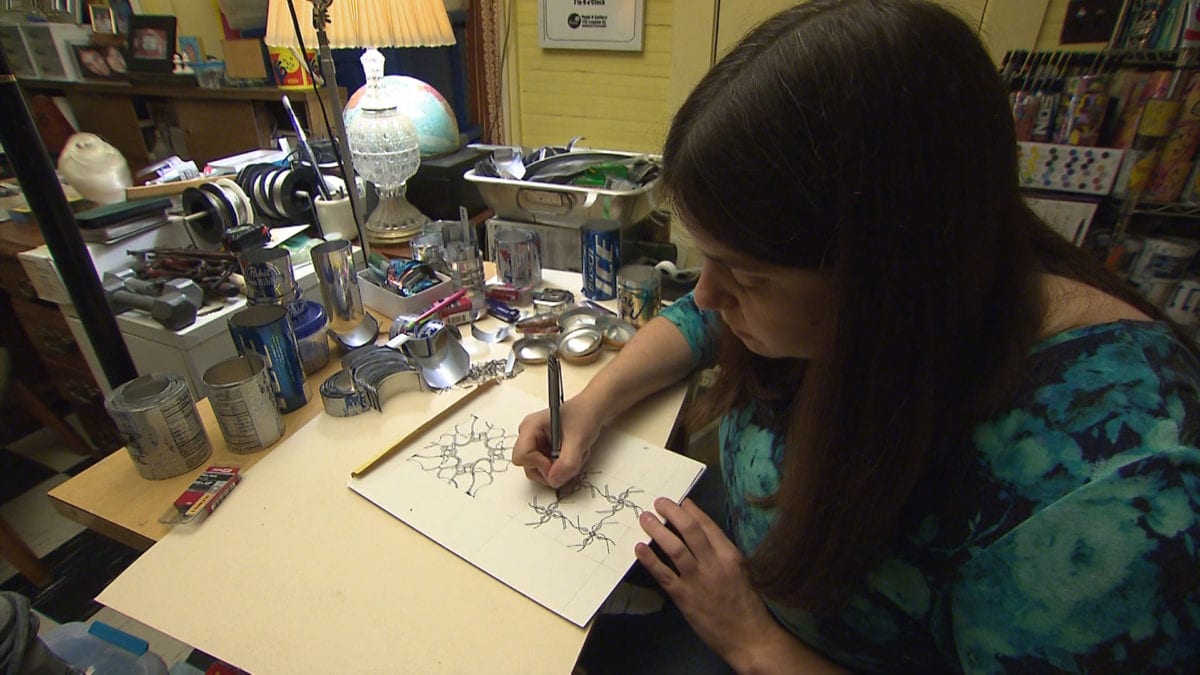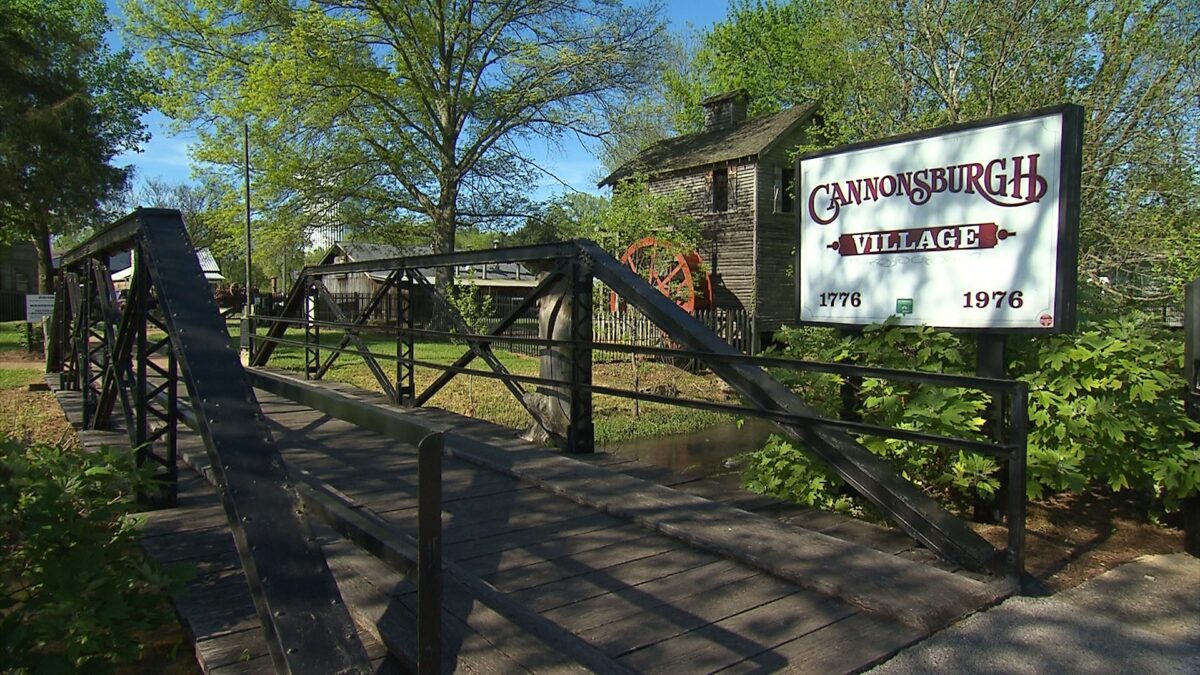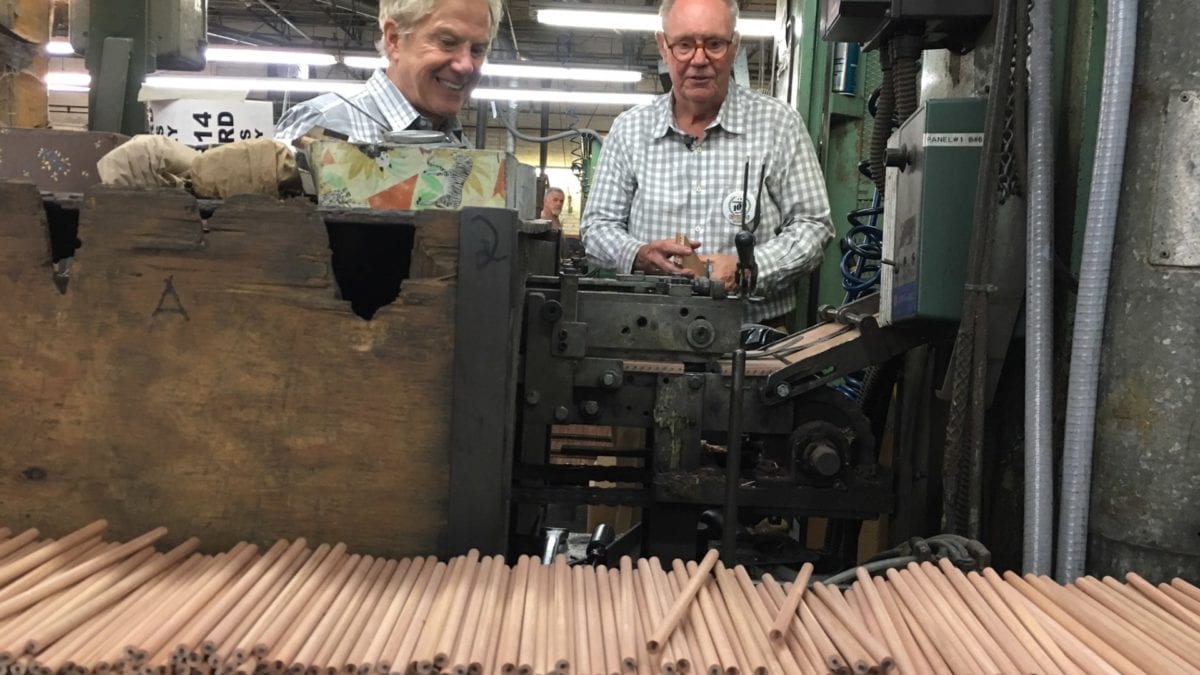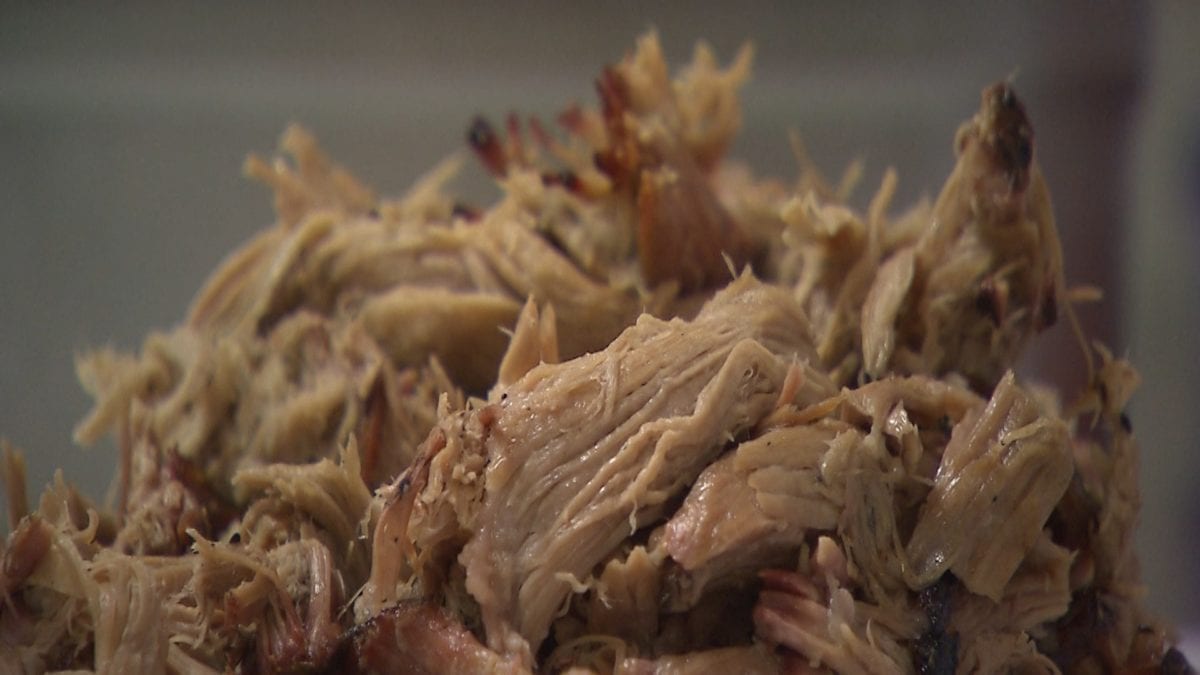- [Joe] This time on Tennessee Crossroads, we explored the captivating history of Cannonsburgh Village in Murfreesboro. Then to our remote barbecue, mecca and the community of Bryson, We'll share the story behind this church's stained glass in Clarksville and visit a century old Shelbyville company that's made its mark the old fashioned way. So you will like the show, I guess? Hi, I am Joe Elmore. Welcome again to another Tennessee Crossroads. Back in the mid 70s, the people of Murfreesboro decided to celebrate its past by recreating it. The result of this ambitious project is a place called Cannonsburgh Village. Rickey Chick paid a visit to explore this little gym that represents over a century of Tennessee's bygone years.
- All right, if you'll just follow the lady with his son.
- Okay.
- We'll go right through here and we'll going in through the gate.
- [Rickey] There's a magical place in Murfreesboro, where a quick turn off the busiest street in town also turns back the pages of time. The historic village of Cannonsburgh has been a part of the Murfreesboro parts department for nearly 50 years. But the buildings that make it so special have been around much longer than that. As parks director Nate Williams explains.
- In 1974, the city embarked on a national Bicentennial project. The whole nation was celebrating, encouraged communities across the United States to do something that would be unique to mark the Bicentennial United States so leaders of Murfreesboro at that time decided to create this village, bringing buildings from across the county from the late 1800s to early 1900s. And they ended up winning a national award, third place in the country and end up winning $75,000. And an interesting fact it's the only one of these projects that's still around today.
- [Rickey] Part of the reason Cannonsburgh is still around can be attributed to a devoted staff and volunteers, time traveling tour guides like Kathy Owen who bring the village to life.
- A lot of them are folks that came on tours with their grandchildren and became interested in the place and said, "Hey, what can I do?" And we have several that are retired teachers and they love it.
- Throughout our park system, we have tons of volunteers, we recognize them every year and Cannonsburgh is a huge percentage of that. They come out and they bring their expertise and their passion for these buildings in this area. We can't say enough how much we appreciate all they do to make this village what it is.
- What in the world have we got here? I've been looking for some Desperados.
- [Man] You got 'em man.
- Man this is a desperate looking crew I'm also not only the Marshal issue at Cannonsburgh, I'm the truancy officer.
- [Rickey] But Marshal, these kids are in school. What better way to learn than by immersing them in a bygone era surrounded by actual buildings and artifacts from Rutherford County's past?
- We do a lot of school tours. So when we had the school tours lined up, I'm the one that kind of organizes and gets the kids started, I generally start with the mill. There are a lot of mills in this area. The equipment in the mill is over 100 years old and it actually does work. The schoolhouse is very interesting. It's set up as a conscription school. And the people that lived in the community would pay the teachers to come in and the teachers would actually take turns living with the different families. That seems to be the favorite thing of a lot of the children on the tour. And it's real different for them that seems to be one of their favorites. It's interesting. I always try to ask them what's missing from the buildings, the children, and first off, they'll say a computer. Then they'll finally come to the fact that there's no bathroom. But they seem to like the parts that they're not even familiar with.
- [Rickey] A telephone switchboard certainly falls into that category. Like the one and Miss Ada's house.
- It was the home of Miss Ada Rowland. She was employed by a private telephone company. She came as a widow with a young child. We actually have her original switchboard and battery cabinet. She was on call 24 hours a day and actually knew everything that happened in the community before anybody else.
- [Rickey] Wouldn't that be a dream job for the town gossip? Listening to Kathy, it's easy to tell that she's found her dream job as well. So Kathy, tell me about the Layman house. The Layman house is my personal favorite. It was actually located outside of Murfreesboro. There were 10 children raised here, five boys and five girls. They had a rather large farm, tobacco and cattle raisers. And we are lucky enough to have some of the family that still comes around and can share stories of thanksgiving and all sorts of things.
- Any idea what this is? Most visitors don't know what this is. But back in the day, for those of us who were vertically challenged, it was a very handy device. It's a mounting block and it was used so women could mount their horses. And when those horses needed shoes, where did they go? The local blacksmith of course,.
- An interesting thing about steel, see the magnet sticks to the steel, but when it gets to critical temperature that orange hot, it doesn't stick anymore.
- [Rickey] Now, if you prefer horseless carriages, you can check out the classic cars at the Stone's River Garage. But beware, it's a speed trap. Must be related to that Marshal.
- Uh-huh, uh-huh
- And this is just a great place for people to come and pause for a second and reflect on more simple times.
- You might have heard your grandparents tell you about it. But if you come here, you really get to experience it for just a little while. It's a taste of a life that doesn't really exist anymore.
- [Rickey] Except in a magical place, near a busy street, in the borough.
- When you go to get barbecue, you'll often get a side order of potato salad or big beans. Well, Rob Wilds likes both along with a side serving of history and that's what he found when he went to the Corner Pit BBQ in the community of Bryson.
- [Rob] When you come to Bryson, Tennessee between Pulaski and the Alabama line, you'll find the Corner Pit BBQ and that's about it. Kristen Pfeiffer, one of the owners of the pit says that wasn't always the case here.
- This used to be a town, there was a blacksmith shop over there, there used to be a store right here, there was a hattery here. And then I guess when the economy changed in the 40s and everybody moved and left. This little town just went away.
- [Rob] Kristen's husband Bill actually bought the place and convinced Kristen and the rest of the family that the pit should be reopened. It'd be good for business, you see.
- I'm a farmer foremost and I got the restaurant to be able to market my beef. So that was the only reason I bought it, was to be able to find a way to be able to market our farm products. And it turned out well. Number 31, right here.
- [Rob] No doubt but bill also had another motive for reopening the place. Which has been here in some form or fashion since 1965, to save some of the history of the pit and of Bryson. There's lots of history on this little corner of Tennessee. In fact, this place right over here, been through a lot since it first became a barbecue place back in 1965. It's burned six times. Now if you were a pessimistic man, you might say, I don't believe I'll buy this place and put another barbecue restaurant in it. But Bill Pfeiffer is not a pessimistic fella. He's an optimistic man. Optimistic, but careful.
- We moved the pits slightly away from the building. I started thinking of the situation that's the problem, was the pits are too close. So we have an enclosed pits that are still all wood fired, but we got them just a little ways away from the building, we're not going to repeat it .
- [Rob] No more fires except the one that keeps the barbecue coming.
- We cook fresh every night and we start out about 10:30-11:00 o'clock or whatever. My son comes in, preps the meat and we get it on the grill. We try to make sure it's on that smoker no later than 11 o'clock at night. We cook it all night long. I come in about 5:30, make sure the fire's right, get it going good. And then we wrap it and let it wait until 11 o'clock when everybody shows up. And we sell one brisket every Saturday. Now sometimes we sell one brisket every 12 minutes.
- [Rob] There's some fire too in the barbecue sauce. A recipe for which has been closely guarded for half a century.
- [Bill] This restaurant came with a sauce. It's called original hot are the tools that have been here since 1965. Very closely guarded. Nobody would ever let the recipe. One of the previous owner's wife was nice enough to give us that recipe. And we've been able to start making the sauce for here and it is really what makes this place is the sauce. We have people come from Canada, come get a gallon of the sauce. It's a unique sauce. It's like no other barbecue sauce. And it has really been a blessing that we were able to get that recipe.
- [Rob] Customers keep coming back for the sauce and the barbecue and for the Pfeiffer's too.
- We have some friends coming in so--
- So you need some food?
- Some barbecue, you betcha.
- [Rob] Brian Floyd was the very first customer when the Bill reopened the pit long ago and here he is years later.
- Your never tired of what Bill and his crew does here. And they constantly are adding on to the menu. They make their own rubs. They have the finest meats that you can get your hands on. They've added fudge now, the brownies and the pies and so forth. It's just a really great growing concern yet it still has that sort of country feel where you can come here with a group of friends and just relax, have a good meal. How do you beat that?
- Don't need anything else?
- No thanks.
- All right.
- [Rob] It is pretty hard to beat that especially when you toss in the fact that bill loves history. And he said about to decorate the pit with pieces of the past, many from right here.
- [Bill] All the signs are from Dallas County, the gas pump is from Dallas County, different pieces that I know have a history from the county. Some people bring them to me and say look, this needs to be remain here and everything has a story. I don't think there's a piece in here that doesn't have a background to go with it. And people from all over come in and they ask you about something. Well, I can tell them the backstory. It's not like something we just picked up, dropped it on there. Everything has a story and that's what makes it fun.
- [Rob] Take for example the story behind this sign.
- The Sinclair sign was under a brush pile, a friend of mines farm they had pushed up years and years ago. Had pushed up a big burn pile. They took the bulldozer to push the burn pile away and that sign rolled out from underneath it. And he's like you got to come get this. So we jumped on it, flattened it out and got it right and cleaned it up and waxed it up and put it on the wall. It has been a treasure here ever since
- [Rob] Looks like somebody use it for target--
- He did that . But it fits this place cause the buildings a little rough around the edges so everything is in it has to be a little rough around the edges .
- [Rob] Maybe so but the food and the history and the fibers. Make a visit to the Corner Pit BBQ in Bryson. Very smooth and tasty.
- Thanks Rob. The Art of stained glass has been around for ages. And with stained glass is found in churches where there's often a story behind it. Ken Wilshire has the story behind some glass in Clarksville, along with the talented artists he met along the way.
- [Ken] First Presbyterian Church in downtown Clarksville has been a NEO Gothic landmark since 1897, with its towering spires and ornate stained glass windows. But time certainly has taken its toll, especially on these hand carved wooden works of art. They were simply fading away and falling apart. Well when Clarksville Foundry owner Charlie Faust found out he just would not let these stunning rosy windows rot away. So he introduced a way to use the old wooden frames to make molds for casting new aluminum frames. And after they were cast, he enlisted artists Dennis Harmon in a manual studio in Nashville to install new glass and the frames. But it took much more than the innovative expertise of the Clarksville Foundry and a Nashville stained glass artist to bring these beautiful old historic windows back to life.
- Oh, I'm very proud. I'm very proud to have been a part of that. To been asked to be a part of that. It was a great experience.
- [Ken] It took the creative designs of Clarksville artist Miranda Herrick to revive the old glass panels with color and character. So it was just kind of a waste of that architectural element. So they wanted to beautify it, and kind of do something a little bit contemporary and bring a local artist, temporary artists into the project.
- [Ken] But Miranda's talented career started years before the window project, she says for as long as she can remember. She's always been to create works of art.
- In school people are always like, "What are you gonna do when you get out of college?" It's like, I don't really care. I'm just enjoying being in college and making art right now. So luckily I did. My career is largely in art. I kind of figured if I did what I enjoyed the rest would kind of fall into place and it generally has.
- [Ken] Well generally, her designs are geometrical, symmetrical and vibrantly colorful.
- They're very immediate, I don't know what it's gonna look like. I start off with maybe a pencil grid and start drawing, just decide where I'm gonna start and how I'm gonna repeat where I'm gonna repeat and then I just build like, I'll make a shape, do it however many times I want to repeat it. And while I'm creating that shape, I'll think, what shape is next but I don't know what my drawing is gonna look like until I'm done.
- [Ken] And once she's done with her intricate pen and ink drawings, she carries the geometrics to another more metallic medium, as in old soda and beer cans, hundreds of them.
- So I'll even be cutting up the cans and preparing them and then notice the shape on the can and say, how can I arrange that? How can I make that more interesting and I'll cut them out and just move them around and play with them.
- [Ken] Like the Clarksville Foundry used recycled aluminum and casting the new stained glass windows. Miranda does the same with her artwork.
- I think the pattern based quality of my work makes people think about how much they use of something. Technically it is recycling, of course I don't use every little bit, what I don't use, I take to the salvage yard. So I'm definitely invested personally in trying to recycle or reuse the things that I consume.
- [Ken] Miranda cuts and handles hundreds of different shapes and sizes of sharp aluminum pieces. So you would think a box of bandages would be nearby.
- It would be you a pretty uncomfortable paper cut but nothing that would send me to the emergency room. The most dangerous part is probably when I'm preparing the cans and I'm cutting off the top and the bottom and I use a box cutter. So I just have to be very careful where I place my fingers and thus far things have gone well .
- [Ken] When you talk about discipline, to most folks Miranda's projects are repetitious and monotonous. But this is what she loves about her artistic assembly line.
- I love sitting here in my studio and just repeating these actions and enjoy the process. It's like I'm influenced by everything that has a pattern, from my grandmother's quilting to Islamic tile work, all of that impresses me and I've just soaked it in my whole life, I love pattern. I also enjoy that the creativity doesn't necessarily end when the piece of artwork goes out of the studio because someone can rearrange it in the gallery, take it home and change it to their mood. So done a few pieces that have that rearrangeable element to them.
- [Ken] Well, another example of her passion for repetition, it's this book. She panned 365 unique drawings, one for every day of the year and this is just the beginning.
- Someday I might spend all my time quilting, all of the different creative processes are fascinating to me.
- [Ken] Wide LED lights installed and the new windows allow them to cast a warm, welcoming glow upon the community once again. Thanks to Miranda and the others who helped save them. And like the windows, Miranda's eyes shine brightly with every snip of her scissors and stroke of her pen. It's her own kaleidoscopic view of this creative journey she's on that guides Miranda Herrick along the way.
- Thanks Ken. Did you know that cursive writing has made a comeback in many elementary schools? Well, that's good news for a little Tennessee company that's been in operation for more than a century. The Musgrave pencil company in Shelbyville has stood the test of time and digital technology as one of the leading manufacturers of good old wood case pencils. The first practice of writing to record language goes back to about 3200 BC. Well, technology has affected the ways people have written since then. Arguably the most reliable writing instrument is still been time tested wood case pencil. Since 1916, the Musgrave Pencil Company at Shelbyville has been a leading producer. More than a half million pencils a day, in various colors, shapes and designs. It all began when founder James Raford Musgrave started milling cedar wood slats for sale to German pencil makers. He devised a plan to provide local farmers with modern wire fencing in exchange for their cedar fence rails.
- Cedar is a fairly dry grain soft wood with a natural oil in it. Cider oil of course and it made just a really premier pencil.
- [Joe] Henry Hulan now heads the company his grandfather started. A company that's made its own complete pencils since the early 1920s. Just like the old days, the process starts with wooden slats now often imported from places like California. So how did they get the lead inside the wood? First let's get something straight, pencils do not contain lead.
- And never has been, it's a mixture of graphite and clay. That's an interesting process unto itself because the more graphite you have and the less clay, the softer the pencil will write.
- [Joe] A diamond cutter puts nine grooves into each slack, grooves that are half the width of the graphite cores which go in next with some glue. and identically, top sled is glued on and the unit goes into a press. Here each side of the sandwich passes through a set of cutters to give it its ultimate shape.
- Then you end up with what we call a roll pencil that's pegs around or flat or whatever shape, we're cutting that is then ready to be painted in some future date.
- [Joe] The next step is more involved than one might imagine. Five to nine thin coats must be applied to each pencil.
- Mostly we're selling a surface to be printed on. And a lot of thin coats as most cases are better than one or two thick coats of paint.
- [Joe] After paint, some pencils will get printing on their sides. Either way, the final phase is typ. First a machine intense the end of the pencil so it receives a metal band called a ferule then an eraser goes into the ferule, which is crypt to hold everything together.
- Now at this station, they started with pencils with erasers on each end. Well, here's what happen.
- [Joe] Actually, they're cut in half and pre-sharpened to like short pencils favored as a gospel. In addition to the standard number two, Musgrave turns out large quantities of these flat carpenter pencils. These are shipped to build in supply houses and even box stores like The Home Depot. Advertising and designer pencils have greatly boosted the business here at Musgrave. Machines like this one use special foils to turn out a myriad of multicolored designer pencils that are sold to stores nationwide. So after a century of operation, business is still good. That's right. A little company that once earned Shelbyville the name "Pencil City" still making its mark in a quickly changing high tech world. What's more Henry Hulen wants to to ensure a place for the low tech Tennessee made pencils at least for another century or so. Do you think you guys will be making pencils another 100 years?
- I don't think I'll be around to watch him but I'm gonna be here a few more years and I think there's a place for the wood case pencil from now.
- Well that's gonna put the wraps on this whole edition of Tennessee Crossroads. You're always welcome here and welcome to check out our website: http://www.tennesseecrossroads.org. Keep up with us on Facebook and by all means, join me here next week. See you then.




